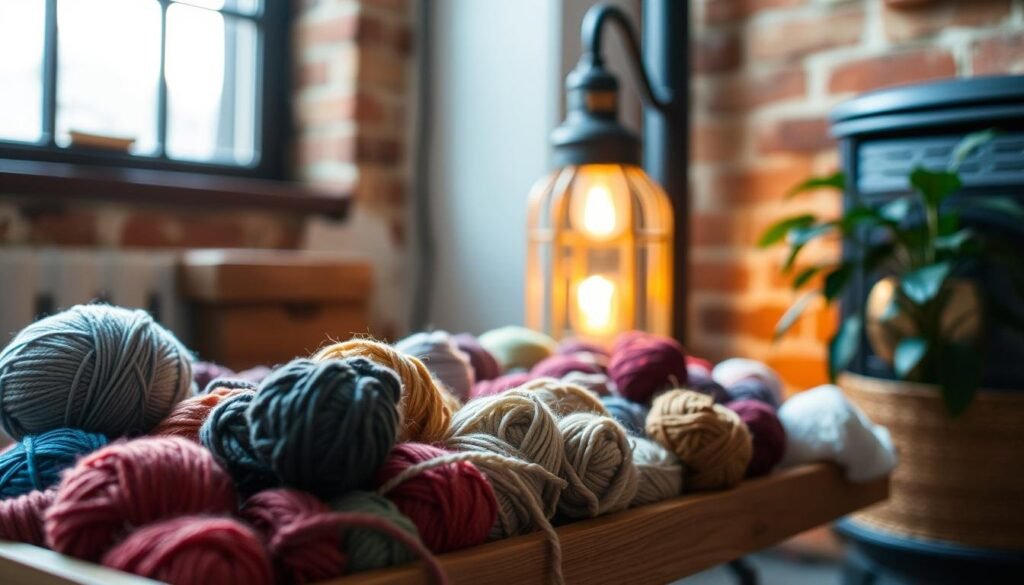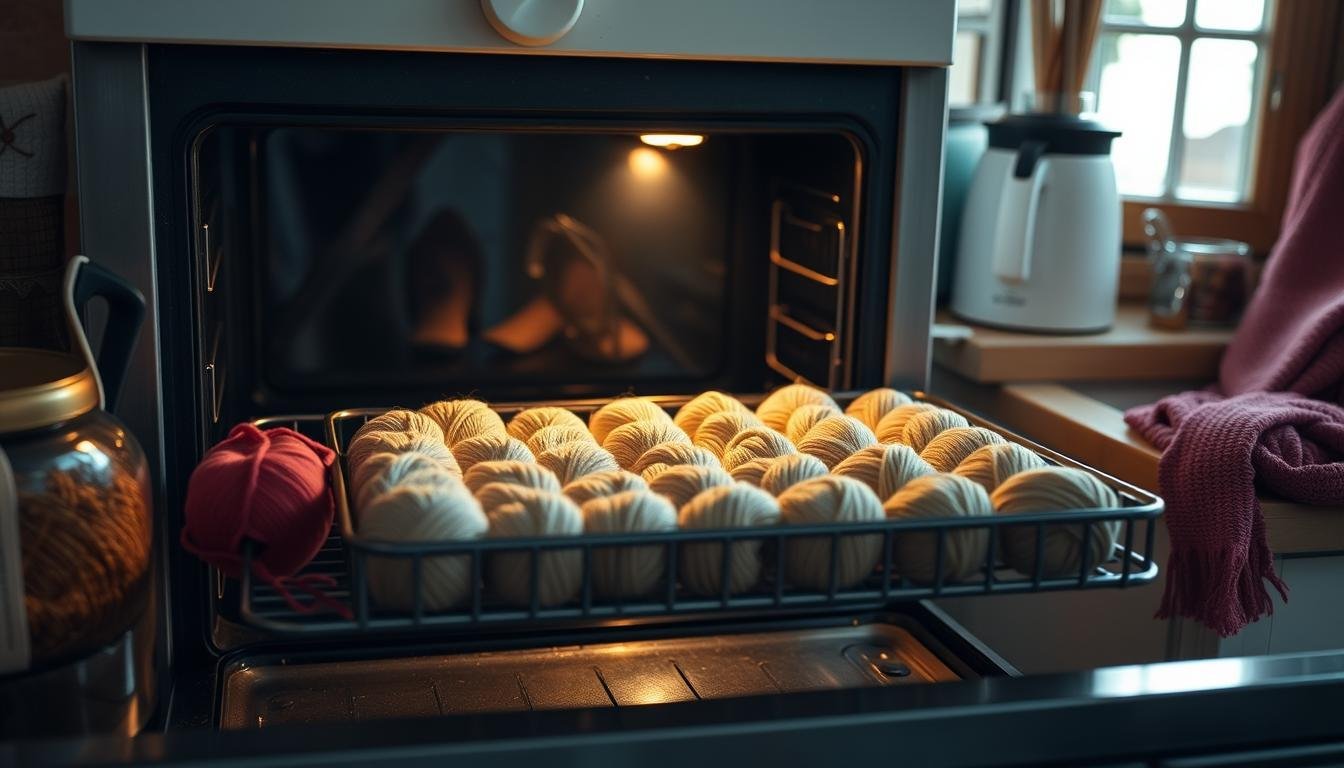Last updated on October 18th, 2025 at 04:42 pm
Yarn in the Oven: Is It Safe? When you’re making yarn projects, you might wonder if it’s safe to use yarn in an oven. Knowing about yarn safety is very important to stay safe.
Yarn’s makeup and how it handles heat are important to think about. Different yarns act differently when heated, and some aren’t good for oven projects.
Before starting your next project, find out if your yarn can handle the heat. Knowing this helps you stay safe while you craft.
Contents
- 1 Understanding Yarn Composition and Heat Sensitivity
- 2 Can Yarn Go in the Oven? The Definitive Answer
- 3 The Science Behind Yarn and Heat Exposure
- 4 Heat-Safe Alternatives to Regular Yarn
- 5 Craft Projects That Mistakenly Use Yarn in Heat Applications
- 6 Safe Ways to Use Yarn Near Heat Sources
- 7 Real-Life Incidents: When Yarn Meets Heat
- 8 Keeping Your Crafts Safe and Fire-Free
- 9 FAQ
- 9.1 What types of yarn are safe to use near heat sources?
- 9.2 Can I put acrylic yarn in the oven?
- 9.3 What are the health risks associated with burning synthetic fibers?
- 9.4 Are there any heat-safe alternatives to regular yarn?
- 9.5 How can I safely display yarn creations near heat sources?
- 9.6 What are some common craft projects that mistakenly use yarn in heat applications?
- 9.7 What should I do to prevent accidents when working with yarn and heat?
- 9.8 Can cotton yarn be used in oven-related projects?
Understanding Yarn Composition and Heat Sensitivity
The type of yarn you use can greatly affect how it handles heat. Yarns are made from different materials, each with its own set of properties.
Natural Fibers vs. Synthetic Fibers
Natural fibers, like wool and cotton, handle heat better than synthetic ones. Natural fibers tend to be more resistant to heat without melting. But, they can still get damaged or scorched at very high temperatures.
Synthetic fibers, however, melt at lower temperatures. For example, nylon melts at about 428°F (220°C), and polyester at around 482°F (250°C).
- Natural fibers: wool, cotton, linen
- Synthetic fibers: nylon, polyester, acrylic
It’s important to know these differences to safely use yarn in heat-related applications. By understanding your yarn’s composition, you can guess how it will react to high temperatures.
Can Yarn Go in the Oven? The Definitive Answer
Whether yarn can go in the oven depends on its type. Different yarns react differently to heat. It’s important to know this before using the oven. [Yarn in the Oven: Is It Safe?]
Yarns are made from synthetic or natural fibers. Each has its own melting or burning point. For example, acrylic yarns melt at lower temperatures. Wool yarns can handle higher heat before they felt or burn.
Melting Points of Common Yarns
Knowing the melting points of your yarn is key. Here’s a quick guide:
- Acrylic yarn: Melts around 212-250°F (100-121°C)
- Wool yarn: Can felt or shrink at temperatures above 212°F (100°C), but generally doesn’t melt
- Cotton yarn: Can scorch or burn at high temperatures, but doesn’t melt like synthetics
Using yarn in the oven can be dangerous. It might melt, burn, or release harmful fumes. It’s not usually safe unless you’re using a yarn made for high heat.
To keep yourself safe and your project successful, always check the yarn label. Look for information on heat resistance. If unsure, it’s safer to choose another material or method.
The Science Behind Yarn and Heat Exposure
When yarn meets heat, a series of chemical reactions starts. The type of yarn affects how it reacts to heat. Natural fibers like wool or cotton burn or char at high temperatures, releasing harmful fumes.
Synthetic fibers, like nylon or acrylic, melt and release toxic chemicals when heated. This can cause serious health problems, including respiratory issues.
Health Risks of Burning Synthetic Fibers
Burning synthetic fibers releases dangerous chemicals into the air. These chemicals can irritate your eyes, skin, and lungs. Long-term exposure can lead to more serious health issues.
It’s important to understand these risks for safe crafting. Knowing how yarns react to heat helps you protect your health. [Yarn in the Oven: Is It Safe?]
Heat-Safe Alternatives to Regular Yarn
If you’re looking for yarn that can handle high temperatures, consider these alternatives. Crafters often face challenges when their projects need to be exposed to heat. Regular yarn can melt, deform, or even catch fire at high temperatures.
Commercial Products Designed for Heat Applications
Several commercial products are made for high-temperature use. These include ceramic yarns, refractory yarns, and certain fiberglass yarns. They keep their shape and function even in extreme heat.
| Material | Max Temperature | Common Uses |
|---|---|---|
| Ceramic Yarn | 2300°F | Furnace insulation, kiln construction |
| Fiberglass Yarn | 1000°F | Thermal insulation, textile production |
These heat-safe yarns and materials offer new possibilities for crafters. By picking the right material, you can ensure safety and get the results you want.
Craft Projects That Mistakenly Use Yarn in Heat Applications
Many crafters use yarn in projects that involve heat, not knowing the risks. This can include using yarn near open flames or in high-temperature baking.
Some projects that might misuse yarn include items meant for baking or candle use. Ornaments, candle warmers, and potpourri are examples of where yarn is used wrong.
| Craft Project | Heat Application | Risk Level |
|---|---|---|
| Yarn Ornaments | Oven Baking | High |
| Candle Warmers | Open Flame | High |
| Potpourri | Heat Vent | Moderate |
To stay safe, pick materials that can handle heat for your projects. Look for yarn-free alternatives for heat-based crafts. [Yarn in the Oven: Is It Safe?]
Safe Ways to Use Yarn Near Heat Sources
Displaying your yarn creations near heat sources requires safety first. You can still enjoy your yarn crafts safely if you pick the right materials and display methods.
For safe display, use heat-safe options. Glass or ceramic stands are good because they can handle heat. Stay away from wooden or plastic stands that might melt or catch fire.
Heat-Safe Display Options for Yarn Creations
Here are some safe display choices:
- Glass shelves or tables near radiators or heaters
- Ceramic or stone display stands near fireplaces
- Metal display racks with a heat-resistant coating

Choosing the right display options and being careful with heat lets you enjoy your yarn creations safely near heat sources. [Yarn in the Oven: Is It Safe?]
Real-Life Incidents: When Yarn Meets Heat
When yarn and heat come together, the results can be scary. For example, a crafter left a yarn project near a flame. This caused a sudden fire. Such events show how dangerous yarn and heat can be.
Another time, a knitter stored yarn by a heating vent. The yarn melted and stuck together. These stories teach us to be careful with yarn near heat.
Prevention Strategies for Crafters
To stay safe, follow some simple rules. Always keep yarn away from heat. Choose yarn that can handle heat for projects near flames. Also, make sure your workspace is clean and well-ventilated.
By taking these steps, you can enjoy crafting without worrying about yarn and heat. Stay safe and have fun making your projects. [Yarn in the Oven: Is It Safe?]
Keeping Your Crafts Safe and Fire-Free
As you dive into different craft projects, remember to keep safety first. It’s important to know how yarn reacts to heat. This way, you can avoid accidents and keep your crafting space fire-free.
To stay safe while crafting, pick yarn that’s safe for heat. Also, follow all safety rules when you’re near heat sources. This way, you can craft safely and enjoy your hobby without worry.
By using what you’ve learned, you can make crafting safer for everyone. Stay alert, informed, and have fun with your crafting.
See Also: Why Does My Oven Smell Like Plastic the First Time?
FAQ
What types of yarn are safe to use near heat sources?
Natural fibers like wool and cotton are safer than synthetic ones. But, always be careful. Look for yarns made for high-temperature use.
Can I put acrylic yarn in the oven?
No, don’t put acrylic yarn in the oven. It can melt and give off harmful fumes. [Yarn in the Oven: Is It Safe?]
What are the health risks associated with burning synthetic fibers?
Burning synthetic fibers can release harmful fumes. This can cause serious health problems, like breathing issues. [Yarn in the Oven: Is It Safe?]
Are there any heat-safe alternatives to regular yarn?
Yes, there are special products for high-temperature use. They’re safe for craft projects that need to resist heat.
How can I safely display yarn creations near heat sources?
Use safe display options and keep your yarn away from direct heat. Choose materials that can handle high temperatures.
What are some common craft projects that mistakenly use yarn in heat applications?
Some projects, like baked decorations or items near open flames, use yarn wrongly. This can be very dangerous.
What should I do to prevent accidents when working with yarn and heat?
Pick safe materials and work in a well-ventilated area. Have a fire extinguisher ready for emergencies. [Yarn in the Oven: Is It Safe?]
Cotton is natural, but it’s not safe for oven projects without careful testing. It might scorch or catch fire under high heat.

Hi, I’m Leland Benson from Los Angeles. I studied marketing and worked 5 years at LG, selling ovens. From my job, I learned what things are safe to put in ovens. Now, I share simple advice to help you cook safely.

